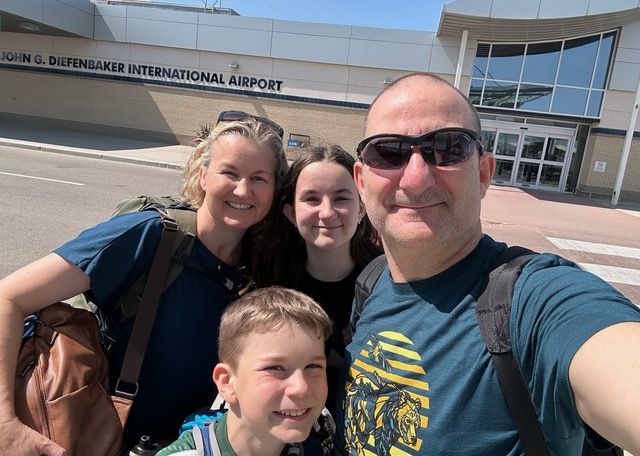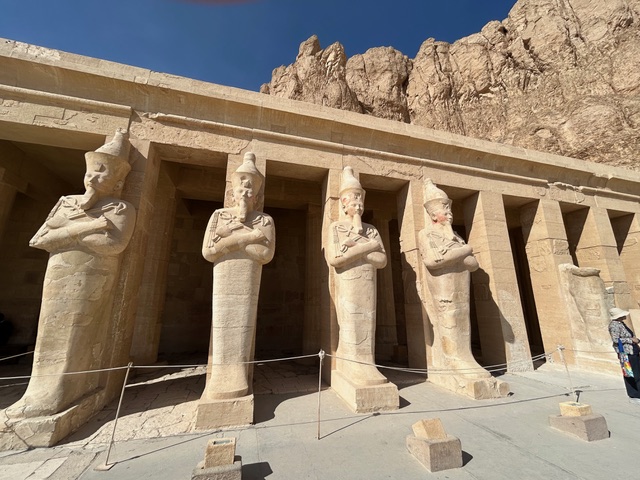We ended the first half of our trip with a four-day, three-night cruise on the Nile which flows North, we travelled from Aswan, upper Egypt to Luxor, lower Egypt. The trip was packed with sightseeing, there are so many amazing sites along the Nile. The cruise boat needed some TLC, but we all enjoyed the sundeck, views from the room and comfortable beds. Aiden loved having a pool table on board, he recruited other passengers, staff members, and family to play as much as possible. Sophie loved 3:30 “teatime on the sundeck” after the first day with her dad, it became a tradition that she dutifully recruited him to enjoy each day. The weather was lovely, not too hot, but comfortable, unfortunately the cool breeze on the sundeck made it difficult to enjoy the ice-cold pool. We had one exception where we truly experienced the Egyptian dessert heat on our last day when we visited the temple of Hatshepsut. She is the only known female Pharo, its unique location captured the intensity of the afternoon sun! We had a fantastic tour guide, Mahmood, he is the father of three. He took a keen liking to Aiden, who repeatedly demonstrated his knowledge of Egyptian history and mythology during our tour. Our tour group was small with only about 12 or 14 people from different parts of the world, but we all got along well and accommodated each other. The cruise had more passengers, with about six different tour groups all in different languages. The food on the cruise was surprisingly good on the boat. We are hoping that the very early mornings prepare us for the time change as we go home for Christmas. On our first evening we visited the temple of Isis and a Nubian Village, clearly a village that relies on the tourist economy where much of the town participates in catering to the tourist and showing us their distinct culture.
The temples we explored on the journey down the nile were incredible, many of them are well preserved or they have restored. It was hard to imagine the work and lost lives that went into building them. It took over 1000 years to build some of them. Again, pictures speak more than words. The hieroglyphics, wall art, and carvings where all amazing. As we were seeing seven or eight temples and having incredibly early starts each day, we elected not to get up at 3:30 am to drive four hours each way to see Abu Simble.
Temple of Isis
The Greeco-Roman Temple of Isis is interesting, showing the influence that Egyptians had on the Greeco-Roman world and some of the cultural fusion of the ancient world. The Egyptian Goddess Isis, representing love, fertility, and protector at sea, her cult spread throughout the Roman empire. She had similarities to the Greece goddess Demitri, thus was accepted into the Greek culture, and in Roman culture replaced the Goddess Venus. A following developing after Alexander the Great’s defeat of Egypt in the fourth century.
Temple of Kom Ombo
We were lucky to visit the temple of Kom Ombo at night. It has a unique design with two parallel axis dedicated to two different gods. The south axis is for Sobek (God of Fertility), his wife Hathor, and son Konahu (the Moon God). The North axis is for the God Horus (God of the sun and sky, God of healing and protection) the son of Osiris (God of agriculture, fertility and the afterlife) and Isis (Goddess who helps the dead into the afterlife).
Temple of Horus at Edfu
The temple of Horus at Edfu is one of the best-preserved temples in Egypt. It is amazing to think such a large structure was completely buried to a depth of 12 meters, many house had to be torn down to excavate the temple. Construction began in 235 BC and finished in 57 BC; it was not discovered until 1860. It honours Horus, the god with the Falcon head.
Esna Lock
Luxor Temple & the Ave. of the Sphinxs
We visited the Luxor temple on our final evening, the winds co-operated, and we were very lucky to have a hot air balloon ride over the city of Luxor on our final morning. We all agreed that this was worth waking up very early (3:30am) for this magical experience. Luxor is a large temple built during the new kingdom era, around 1400 BC. It is dedicated to Amun, his consort Mut and their son Khonsu, it was known for its great annual festival. The temple had two large obelisks, one was gifted to the French government and now lives in the Palace de la Concorde in Paris. The Anubis, Jackal god is the god who ushers souls into the underworld and is a common image seen in this temple. The Luxor temple is connected to the Karnak temple complex by the 2.7 km Avenue of the Sphinxes, there are six shrines along the way connecting the two temples.
Karnak Temple Complex
The Karnak temple complex constructed during the middle period (2000-1700 BC) is a bit overwhelming after many earlier temple sites. With over 30 different pharaohs contributing to construction and its use there are a vast number of different temples, statues, pylons, and buildings. Temples of Amun, Ptah, Montu, Khonsu, Ramses II, Osiris and Opet, and the Scarab monument, to list a few of sites.
Valley of the Kings
In the valley of the Kings 64 tombs have been discovered. We were allowed to enter three of the tombs buried deep in the desert mountains, going underground through these passageways, seeing the mosaics, hieroglyphics and an example of a book of the dead.
Temple of Hatshepsut
The temple of Hatshepsut is a recognizable site from famous images of Egypt. It is the mortuary temple of the only known female Pharoh; it has shrine dedicated to the God Anubis (burial right and guide to underworld) and another shrine to the God Hathor (love, beauty, fertility and pleasure). Two decades after her death the ruling Pharoh of the time attempted to erase and obliterate all references to her rule. There is a fantastic Ted Ed on this subject “The Pharaoh that wouldn’t be forgotten” – Kate Green.






















































































